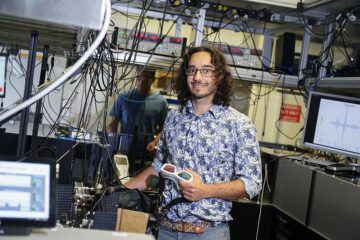Bats as role models….

Siemens presents fascinating material from ultrasound technology at the Expo in Japan
Bats use acoustic signals for their orientation and hunting. Human beings have learned quite a bit from bats. For example, the use of acoustic signals above the audible range of human beings that detect diseases and can be implemented for healthcare. Completely in tune with the motto for Expo 2005 “The Wisdom of Nature“, ultrasound technology has learned from nature. For years now, ultrasound uses sound waves for the purpose of medical diagnostics. Siemens shows a fascinating simulation at the German Pavilion at the World Exhibition in Aichi/Japan. The keyword: Bionics, the teachings of using natural principles for technical applications.
While the sonic waves of bats move in a frequency range between 40 to 80 kilohertz (kHz), ultrasound systems used in medicine work with considerably higher frequencies in the megahertz range. The results are higher image resolution and consequently higher image quality enabling physicians to reach solid medical diagnoses. Modern ultrasound diagnostics are able to display inner organs in four dimensions – that is, in real time. As a non-invasive and patient-sparing examination method it is suitable for a wide range of clinical applications, especially in the area of prenatal care. Between March 25 and September 25, Siemens Medical Solutions will be presenting Expo visitors with a film discussing the principles of ultrasound technology. An ultrasound system (Sonoline Antares) will be at the site as well. At the push of a button, the system will be simulating the results of an ultrasound examination at a separate test configuration. Following the principle of orientation used by bats, the visitor will be able to observe the generation of an ultrasound image.
Background information: ultrasound diagnostics in medicine
Ultrasound waves are acoustic waves from a frequency range not audible to the human ear. Ultrasound diagnostics (also known as sonography) use the fact that high-frequency sound waves are partially reflected at tissue boundaries of various densities. The echoes separated in time are received during transmit pauses by the same crystals of the transducers and processed into brilliant images with special signal and high-performance processors. The frame rate is so high that even rapidly moving organs such as the heart can be displayed in real time. Echocardiography (ultrasound examination of the heart) uses frequencies from 1 to 15 megahertz (MHz). From the first use of ultrasound technology for medicine in 1926 up to viewing the heart with an ultrasound transducer in the year 2001, Siemens was involved in the research and development of this technology.
Ultrasound examinations spare the patient during various clinical scenarios. In addition to examining the fetus during pregnancy, the method is used for organ, soft tissue and vessel diagnostics. Another application is the acquisition of lymph nodes. Siemens is one of the largest international providers of ultrasound systems in medicine.
Media Contact
Alle Nachrichten aus der Kategorie: Messenachrichten
Neueste Beiträge

Neue universelle lichtbasierte Technik zur Kontrolle der Talpolarisation
Ein internationales Forscherteam berichtet in Nature über eine neue Methode, mit der zum ersten Mal die Talpolarisation in zentrosymmetrischen Bulk-Materialien auf eine nicht materialspezifische Weise erreicht wird. Diese „universelle Technik“…

Tumorzellen hebeln das Immunsystem früh aus
Neu entdeckter Mechanismus könnte Krebs-Immuntherapien deutlich verbessern. Tumore verhindern aktiv, dass sich Immunantworten durch sogenannte zytotoxische T-Zellen bilden, die den Krebs bekämpfen könnten. Wie das genau geschieht, beschreiben jetzt erstmals…

Immunzellen in den Startlöchern: „Allzeit bereit“ ist harte Arbeit
Wenn Krankheitserreger in den Körper eindringen, muss das Immunsystem sofort reagieren und eine Infektion verhindern oder eindämmen. Doch wie halten sich unsere Abwehrzellen bereit, wenn kein Angreifer in Sicht ist?…





















